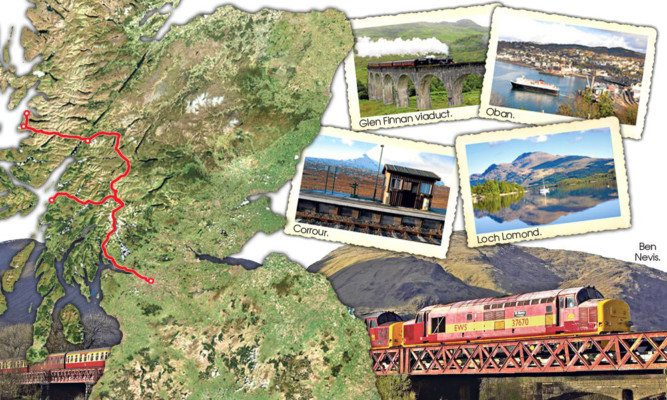
The stunning West Highland Line celebrates its 120th anniversary.
It brought tiny communities into the body of Scotland and opened up the wilds to the masses. For decades it was a vital lifeline before facing being lost forever.
Now the nation’s most scenic railway line, topping a poll as “the top railway journey in the world”, has not only been saved but is positively thriving.
The West Highland Line is celebrating its 120th birthday with tourists flocking to it in their masses. And, on the 30th anniversary of the introduction of hugely popular steam journeys like those featured in the Harry Potter films, a new book celebrates the iconic line.
“There’s so much rich history and such stunning beauty that there’s nowhere like it,” said Gordon Webster, author of The West Highland Line Post-Beeching.
Running more than 140 miles from Glasgow to Mallaig, with a separate line to Oban, the first section opened in 1894.
Built by the West Highland Railway the wild, barren landscape that’s such a winner with travellers was a nightmare for engineers.
The Glenfinnan viaduct was a pioneer of construction, with its 21 arches built entirely of concrete without reinforcing. And Victorian creativity had to be at its sharpest elsewhere, too.
“The track was basically sinking as they tried to cross the Rannoch Moor,” says Gordon, who has trains in his blood as both his grandads were railwaymen. “It’s 50 square miles of just heather and peat bogs and it was totally waterlogged.
“The engineers had to build a special foundation of earth and brushwood anything at all they could to create a raft. So the railway essentially floated across the moor. Even today you can actually feel the train almost bouncing its way across.”
For the tiny communities along the way, the railway became an absolute lifeline. Just as Tesco and Asda delivery vans wend their way along the country’s roads today, the steam trains did just the same thing from the line’s inception.
Drivers were on first name terms with those living in the little cottages and would drop off the groceries they’d picked up for them in Glasgow. Even their water would come from the loco.
But there were suggestions after the infamous Beeching report that closed thousands of miles of lines in the 1960s that this remotest of lines may face the axe. That spectre was raised again in the 1980s, but people power, steam power and Potter power saved the day.
The furore caused by threatened closure actually gave a boost and the introduction of the Fort William to Mallaig steam train in 1984 was a massive success. Such is the demand the Jacobite Steam Train, now operated by West Coast Railways, has been expanded to run seven days a week with two, not one, trains a day. The number of regular daily services to Oban from Glasgow also doubled, to six.
And Harry Potter worked his magic, too.
“When they filmed on the Glenfinnan Viaduct the reaction was amazing,” says Gordon. “Films fans flocked to it and the line got such a boost. Almost overnight Potter fans were queuing up to see where Harry had been.”
The romance of the line is such that one young lover managed to get the steam train stopped on the viaduct so he could pop the question to his girlfriend.
And, just as the line brought connection and prosperity a century and more ago, that continues today.
“Just as it always did, it brings tourists now from literally every corner of the world but it still serves the local community,” adds Gordon, who is also a leading light in the Friends of the West Highland Line.
“You’ve got Corrour which is the highest railway station in the UK and only accessible by train having built a restaurant because of the scores of hillwalkers getting off.
“And we’re cutting back trees that have grown up, especially around Loch Lomond, so the beauties that have made the line famous aren’t hidden.
“It’s all looking very positive 120 years on.”
Scotland in the Steam Age
Scotland was at the heart of the world’s steam railways, making locomotive engines that pulled trains with millions of passengers and vital goods.
Glasgow was key with railway works employing tens of thousands of skilled craftsmen. The Springburn area thrived with several bustling factories, as did Polmadie through the famous Dubs & Company works.
Now a new book is marking that rich history. Scottish Steam: A Celebration has been produced to coincide with the 150th anniversary of the founding of Dubs & Company.

Enjoy the convenience of having The Sunday Post delivered as a digital ePaper straight to your smartphone, tablet or computer.
Subscribe for only £5.49 a month and enjoy all the benefits of the printed paper as a digital replica.
Subscribe